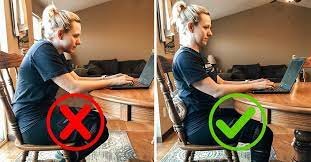The Truth about ‘Good Posture’
The Physiotherapy and Medical industry has drilled into our upbringing that we should look after our ‘posture’ to prevent neck and back pain, or to avoid developing a hunchback.
But how true is this age-old belief?
And is there any merit in efforts to make all office workers sit upright in the most ergonomically correct position?
WHAT IS TYPICALLY ACCEPTED AS ‘GOOD POSTURE’?
You know the one.
Back straight. Head back, Shoulders Down. Chin tucked.
I’ll pluck an image straight from Google.
If you work in, or have ever worked in a corporate office job, I’m sure your induction training would have included some advice on how you should sit more like the person on the right, and less like the left.
WHAT DOES THE RESEARCH SAY ABOUT POSTURE?
There is emerging evidence that is suggesting that there is no such thing as ‘perfect posture’, and that sitting upright too much may even INCREASE your risk of developing neck pain.
A 2021 research paper by Richards K et al looked at over 600 individuals and essentially classified them as having an upright, hunched, or ‘intermediate’ posture.
Over a 6 year period, the individuals with an upright posture, commonly accepted as ‘good posture’, had the highest incidence of neck pain of all the other groups.
To support this, there are many research articles that fail to find even a slight association between having ‘good posture’ and ‘reduced pain’.
DOES THIS MEAN THAT WE CAN SLOUCH ALL DAY?
Now you know that there’s no such thing as a ‘perfect posture’, does that mean it’s harmless to binge netflix while slouching on the couch all weekend?
Probably not it seems.
Another 2021 research paper by Waongenngarm P et al found that office workers who were encouraged to take more ‘active breaks’ and stretch during their work day had significantly less occurrences of back pain compared to their colleagues who only got up when necessary.
WHAT IS THE BEST RECOMMENDATIONS REGARDING POSTURE?
Based on the available research published, combined with our clinical experience, here’s what we’d recommend!
Your BEST posture is your next one, so if you’re desk bound, you can try slouching for 20-30 minutes, then change to a more upright position for 30 minutes, then maybe lean to the left, and so on.
Try to get up every 45-60 minutes to stretch out and alleviate some pressure off your lower back.
Incorporate regular exercise to maintain your muscle strength and capacity.
If you have difficulty trying to sit upright for periods during the day, consider a brace like this Posture Corrector Brace to help.
If you have persistent, or recurrent pain after trying the above methods, consult with a Physiotherapist for a detailed assessment of your condition.
CONCLUSION
For most, the recommendations to move more and alternate your posture frequently will already help significantly. However, for those who need extra help, we’ll share in our next blog some specific rehabilitative exercises we commonly prescribe to those who come in with ‘poor posture’, or what we call, posturally driven pain.
For a detailed assessment of your ‘Posture’, and how you can help, contact us to to find out how we can help!
ABOUT THE AUTHOR
Ryan Tan is our Clinical Director and Physiotherapist here at Physiologic Hong Kong. He’s had over 10 years of experience as a sports and spinal Physiotherapist. He has acquired his Certificate of Spinal Manual Therapy (COSMT), and is also trained in Osteopathic Spinal Manipulations (OMT SM), both advanced courses focussing purely on Spinal conditions, including postural disorders. He has extensive experience working in Complex Pain Clinics in London, treating complex spinal conditions that have been through Spinal Surgeries and procedures. Ryan now works closely with Orthopaedic Spinal Specialists to provide collaborative care and expert Physiotherapy treatment to those suffering from back pain. If you have a complex Spinal injury that hasn’t been able to be resolved, contact us for a no obligation assessment!

